Evergreen trees are appealing for their year-round presence and value for screening, privacy and wind protection. In colder regions most evergreen trees are coniferous; their modified needle-like leaves make them resistant to extreme cold and strong winds. In warmer regions, which experience higher temperatures and periods of drought, evergreen leaves are tough and leathery to minimise water loss.
Some lend themselves to trimming and training. This can be used to restrict size and influence shape. Varieties of ilex, Magnolia grandiflora and photinia are increasingly used to train as pleached trees which give elevated screening around garden boundaries. Yew (Taxus baccata), evergreen oak (Quercus ilex), pittosporum, olive (Olea europaea) and bay (Laurus nobilis) can all be pruned to create more compact trees trees, formal or informal.
Some large evergreen shrubs are frequently grown as small, evergreen, multi-stem trees. This means there are several stems growing from ground level. These are stripped of their side branches leaving a head of foliage around 2m above ground level. Pittosporum and bay are frequently grown in this way. In smaller gardens they make excellent fast growing, but controllable small trees that soon give screening and privacy.
Jump to
Evergreen trees: everything you need to know
What are evergreen trees?
In temperate regions most trees are deciduous. They have a dormant period from sometime in autumn, when they lose their leaves, through to spring when new foliage unfurls. Their appearance changes with the seasons. Evergreen trees on the other hand retain their foliage throughout the year, or appear to. They do shed their older leaves as they grow, but the leaf loss is more gradual and usually occurs within the head of the tree as new growth is produced at the ends of the branches.

When to plant evergreen trees
Evergreen trees are always planted as either container grown plants or root-balls. Container grown plants can be planted at any time, root-balled trees, lifted from the field, are planted from mid-autumn through to early spring. This is the ideal time to plant all trees because the ground is moist and the weather cooler so trees can start to establish before new growth commences in spring.
How to plant evergreen trees
Good ground preparation to break up the soil and add organic soil conditioner before planting is essential. Always dig a hole larger than the rootball or pot the tree is grown in. Break up the ground at the base of the hole using a fork before positioning the plant in the hole. The rootball of field grown trees is usually wrapped in hessian and sometimes supported with wire. This should be left in place to avoid disturbing the roots. The tree will need staking and securing with a strong tie during its early years. Water thoroughly at time of planting and during the first season.
When and how to prune evergreen trees
Most evergreen trees will require little or no pruning unless their size and shape is being influenced. Pruning is best done before a new flush of growth; early spring is ideal. Larger, more mature trees are always best pruned by an experienced and qualified tree surgeon.
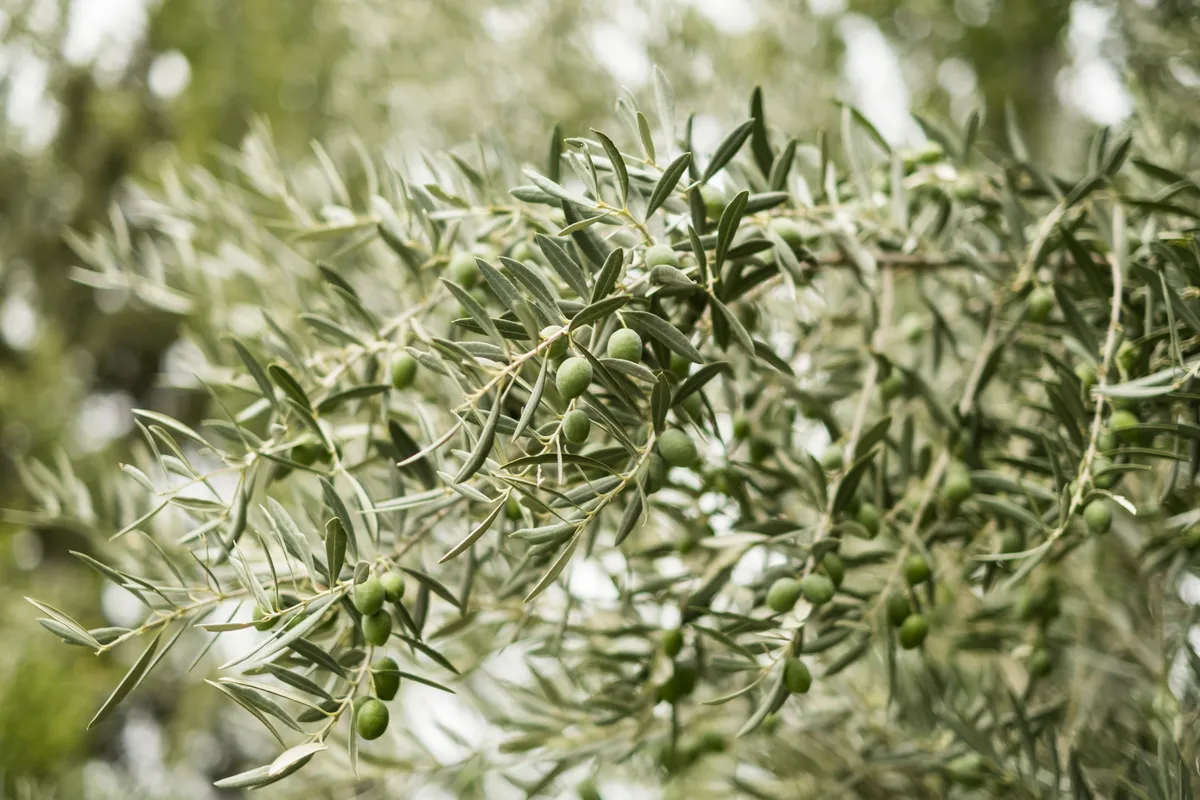
How big does an evergreen tree grow?
The ultimate height and spread of a tree depends on the species and the growing conditions. Some take many years to reach their ultimate height and this may be irrelevant to the gardener. The speed of growth and the impact of the tree in the required timescale is the most important consideration.
To give some idea: a small tree can attain a height of 5-10 metres in 20 years or so. That is up to the height of a two-storey house. A medium sized tree would be well over 10 metres in 20 years, but is unlikely to get larger than 20 metres. A large tree, Cedrus deodara for example, will just keep on growing for a couple of centuries in the right conditions, so it needs the space of a very large garden or park. Its ultimate proportions will not be enjoyed by the gardener that plants it.
Heights given here are estimated after 10 years in adequate growing conditions, assuming a tree 2m+ is planted in the first place.
How far apart should evergreen trees be planted?
Estimating the potential spread of a tree is never easy. There is always an inclination to plant too close in an attempt to achieve screening as quickly as possible. A good guide is 5m minimum between trees; that allows 2.5 metres each side of the centre of each tree. Most will achieve this easily within 10 years, often sooner.
Ten of the best evergreen trees for your garden
Arbutus unedo (5m x 5m)
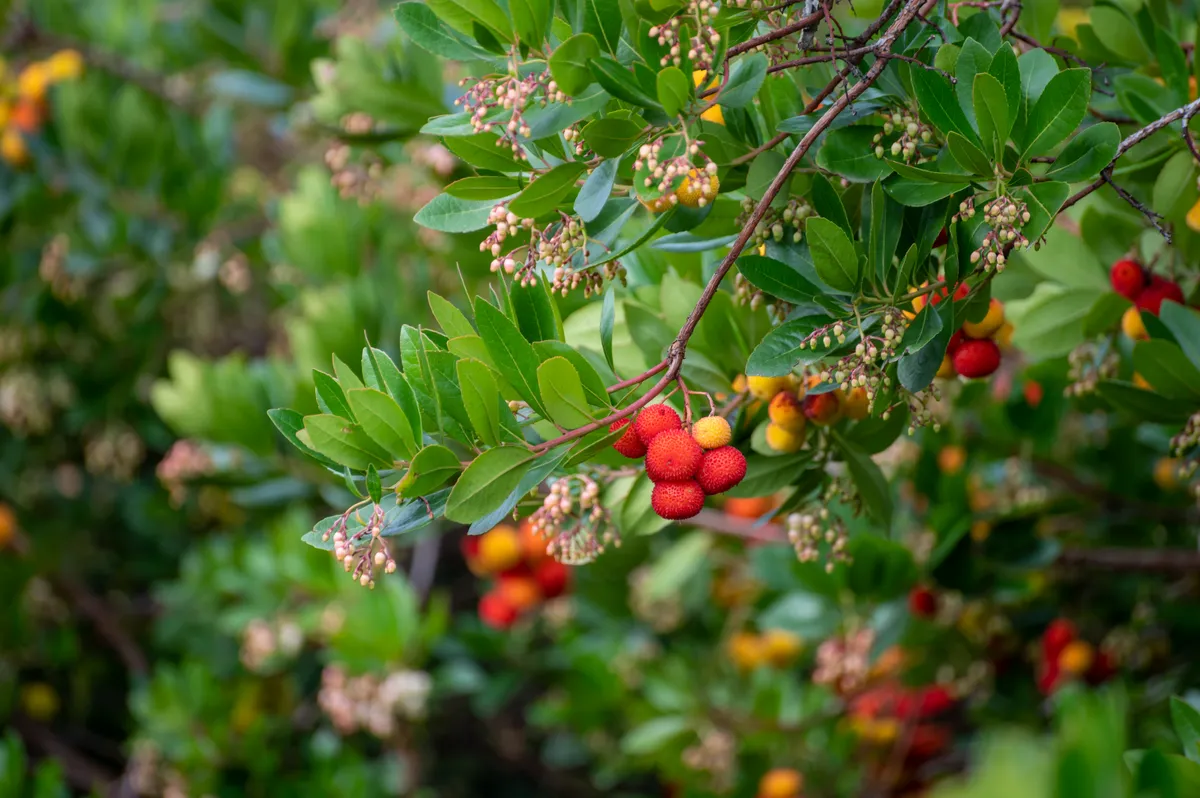
A lovely small evergreen tree with dark green leathery leaves and cinnamon-coloured, shredding bark. Shrubby to start with it is usually grown as a multi-stem tree; the bark is revealed as the tree grows and the lower branches are removed. The pink-tinged white flowers resemble lily-of-the-valley and are carried in loose clusters in autumn, at the same time the round scarlet fruits from the previous year ripen. The fruits resemble strawberries, hence the common name, Strawberry tree.
Although ericaceous, arbutus will grow on chalk and succeeds on most well-drained soils. It dislikes cold winds and waterlogged soil and is at its best in milder locations. It thrives in sheltered coastal gardens and is a good choice for small urban gardens where it can be grown in a large container with loam-based compost.
Arbutus unedo ‘Atlantic’ is an excellent cultivar which flowers and fruits prolifically from an early age. Arbutus unedo ‘Rubra’ has pink flowers. Arbutus unedo ‘Compacta’ is smaller and more compact and ideal for a container. Minimal pruning is required, except the removal of any dead or damaged growth.
Good for small urban gardens
Dislikes cold winds and waterlogged soil
Pruning? Minimal needed
Cedrus deodara (8m x 5m)
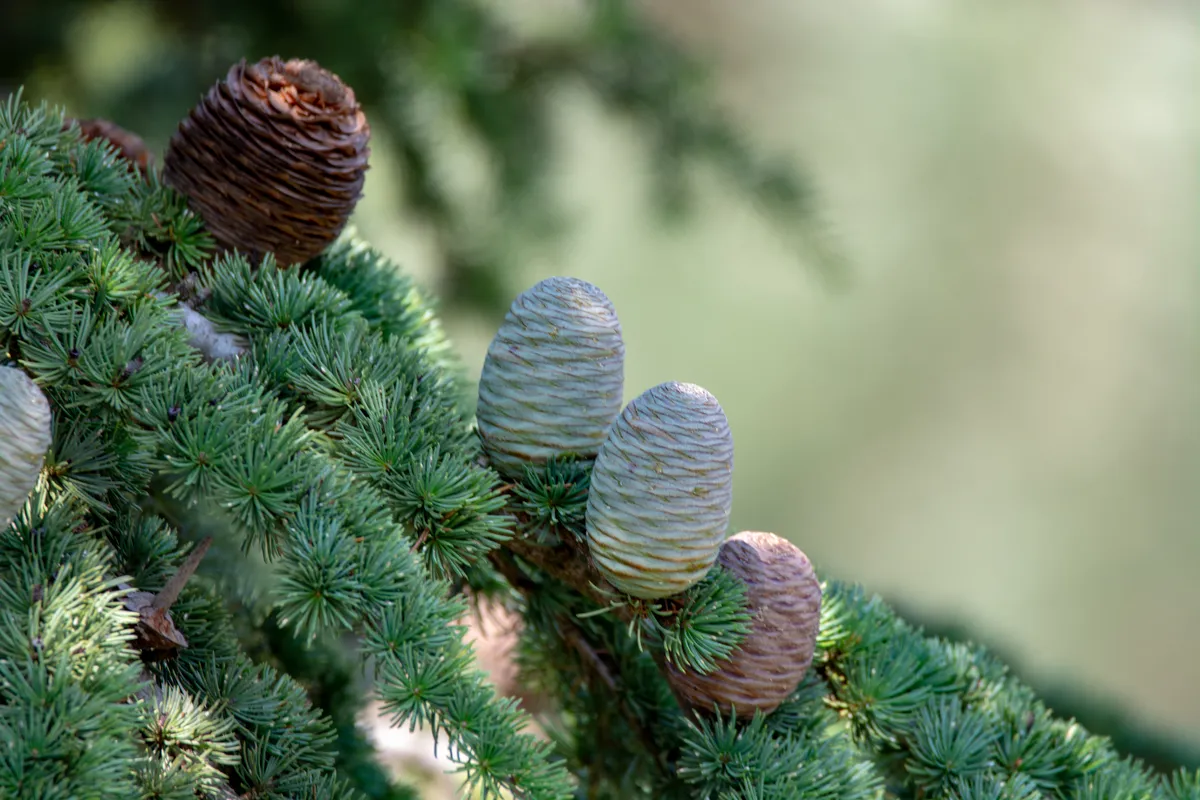
Perhaps the loveliest of the cedars with a softer appearance than most large conifers. The needles are tinged with blue initially, becoming dark green. The elegant branches are drooping with pendulous branchlets. Beautiful from an early age, this is the best cedar for a garden.
Ultimately a very large tree, which could reach 40m when mature, it needs plenty of space. It grows on any well-drained soil and needs an open position without competition from neighbouring trees.
Any pruning will spoil the shape of this tree so it must be given the space to develop naturally. Usually supplied as a field grown root-balled tree it needs careful and secure staking to avoid wind rock which can damage the roots and hinder development.
There are numerous cultivars of dwarf and more weeping form. Cedrus deodara ‘Aurea’ has soft yellow foliage and is smaller growing and slower to develop.
Needs space to develop
Pruning? no need
Eucalyptus gunnii ‘Azura’ (5m x 3m)
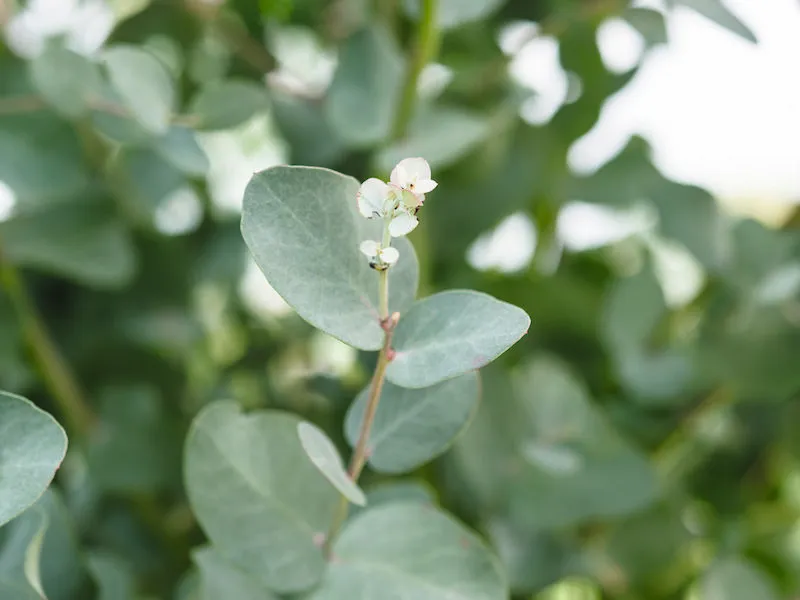
Eucalyptus are mostly fast growing and ultimately large evergreen trees. Eucalyptus gunnii ‘Azura’ is a hardier and more compact form and a better choice for the smaller garden. Mature plants develop striking silver-grey bark which peels to expose cream and green patches. The bright blue-grey round leaves of young plants evolve to lance-shaped blue green leaves as the tree matures. Fluffy white flowers appear in summer and autumn on older trees.
It is at its best grown on neutral to acid soil in an open sunny position. Although drought tolerant, very dry conditions can cause leaf drop and loss of branches. The growth habit is slender and airy and the overall appearance lighter than many evergreen trees. It is a good choice for urban gardens.
Eucalyptus regenerate well from pruning and the foliage is good for cutting. However hard pruning can result in a proliferation of shoots and very bushy growth, so caution is needed.
There are numerous species and cultivars. Eucalyptus ‘France Bleu’ is a much smaller variety reaching only 3m in height. It retains its delicate juvenile leaves and has light, airy growth. It is a good choice to grow as a multi-stem and in a container.
Sun/shade? Open sunny position
Avoid dry conditions
Pruning? Prune with care
Ilex aquifolium ‘Argentea Marginata’ (7m x 4m)
Ilex aquifolium is one of only two broad leaved British native evergreens. (The other is common box, Buxus sempervirens). Because of its spiny evergreen foliage and the ability of some plants to produce shiny red berries in the depths of winter it has been attributed with magical powers since ancient times. It has therefore found a special place in cottage gardens for centuries.
Ilex aquifolium ‘Argentea Marginata’ is female and reliably produces scarlet berries in the presence of a male pollinator. The dark green leaves are boldly edged with creamy white, often with a pink tinge when young. It is upright and open in habit when young, bushy and conical when mature.
It grows on any reasonably fertile soil in sun or partial shade, is extremely hardy and suitable for more exposed situations. Like all hollies it can be slow to grow in the first few years, so is a subject to plant for the long term, rather than for immediate effect.
Hollies respond well to light pruning in early spring to encourage branching and keep the plants in shape.
There are many cultivars. Ilex aquifolium ‘Elegantissima’ is similar, but male, therefore does not produce berries.
Good for berries in winter
Sun/shade? sun or partial shade
Laurus nobilis (8m x 6m)
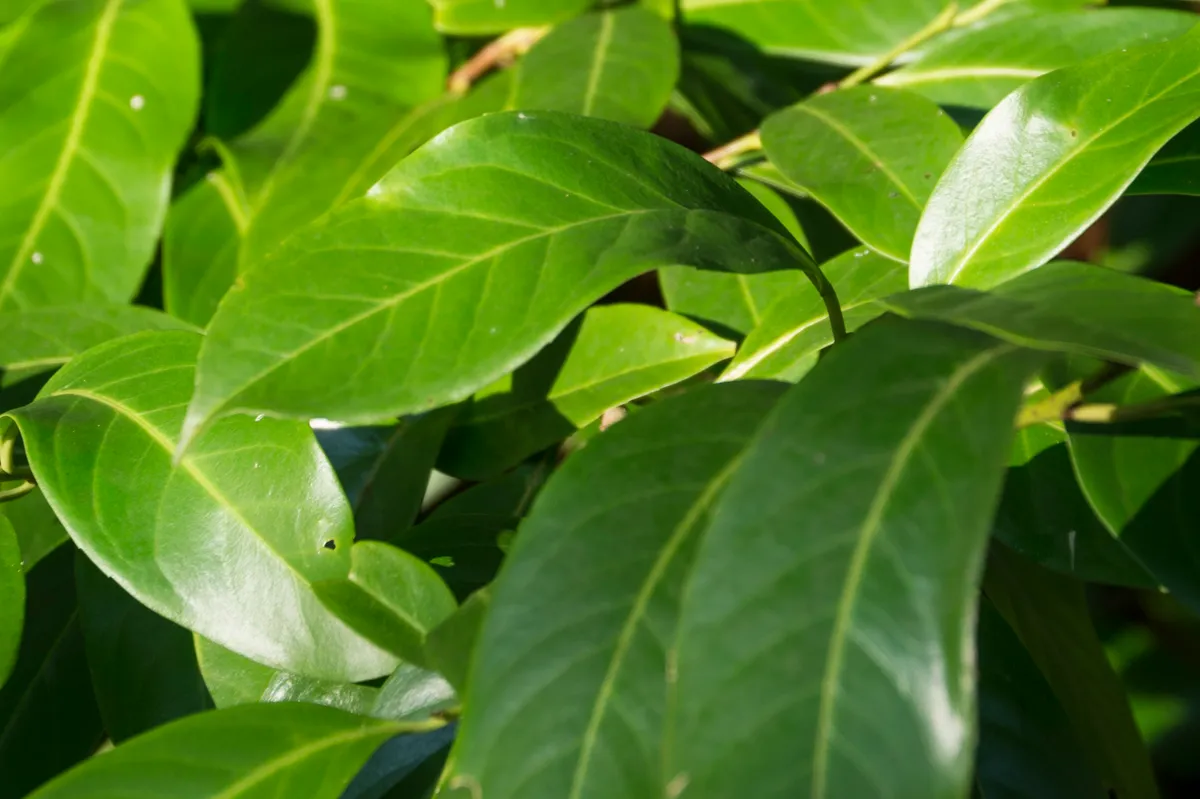
The bay laurel is one of the most versatile evergreens widely grown in gardens. When allowed to grow naturally it forms a large, bushy shrub with several upright main stems and ascending branches. In gardens it is used for topiary, often as cones or standards grown in containers. It also makes an excellent evergreen tree if the lower branches are removed to expose the dark stems. The dark green pointed leaves are strongly aromatic. Small yellow flowers appear in the leaf axils in spring.
A native of the Mediterranean region it is surprisingly hardy and tolerates exposure, including coastal situations. It grows on any well drained soil in sun or partial shade. Growth rate is fast once established and the dense foliage makes it an excellent screening subject.
It can be pruned to influence shape and size, either selectively or with a hedge trimmer for a more formal, denser effect. This is best done in early spring before growth commences.
Laurus nobilis ‘Aurea’ is a form with golden foliage. The colour is at its best in winter and spring, fading as the year progresses.
Good for screening
Pruning? Prune for shape and size
Magnolia grandiflora (8m x 6m)
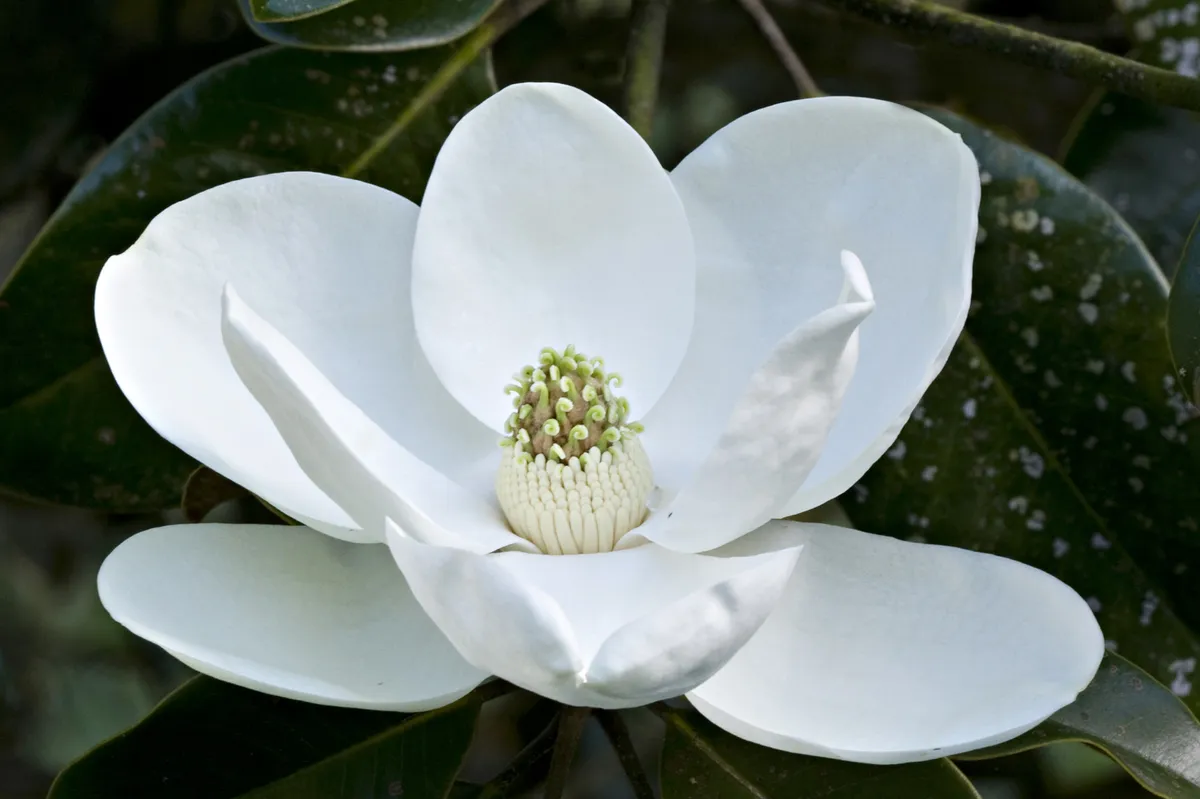
Commonly known as the Southern Magnolia, this has the most magnificent foliage of all evergreen trees. The large leathery leaves are glossy green above, felted russet beneath. The huge waxy blooms appear in summer at the tips of the shoots. Creamy white with waxy petals, their strong lemon fragrance is exceptional.
A native of the southern US it dislikes cold, wet conditions and needs a sheltered situation. A fertile soil with good drainage is required, preferably neutral or acidic, although alkaline conditions are tolerated. Avoid planting too deeply as this can result in failure.
Magnolia grandiflora can be pruned to shape and can be trained against a wall, or on a framework as a pleached tree. Prune only from mid-summer to early autumn. Winter pruning can lead to “bleeding” of sap and die-back of branches.
The species can take years to bloom, some of the named cultivars such as ‘Exmouth’, with olive green foliage, and ‘Goliath’ with dark green leaves are more reliable. Magnolia grandiflora ‘Victoria’ is regarded as the hardiest; it has dark foliage and a stocky, dense habit.
Good for flowers and fragrance
Doesn't like cold, wet conditions
Don't miss our guide on yellow magnolias for the garden
Olea europaea (4m x 3m)

The common olive is one of the oldest trees in cultivation. A Mediterranean native it has become widely grown in gardens where climate permits. In cooler regions it rarely produces fruit, but is prized for its silvery, slender leaves carried on pale grey stems and its architectural form. It is relatively slow growing and perfect for small gardens and courtyards.
Olives need good drainage and a sunny situation to succeed. They are perfect for mild, coastal sites and gravel gardens and are unfussy when it comes to soil type. Ideal for containers they are drought tolerant and survive with some neglect.
Olives can be pruned to control shape and size and this is often necessary to avoid straggly growth. They are pruned in late winter, as they would be for fruit production. The new growth which follows then produces tiny flowers followed by olives, given the right conditions.
Olives are long-lived trees and old specimens produce most attractive gnarled trunks.
Pruning? Prune in late winter
Pittosporum tenuifolium (6m x 4m)
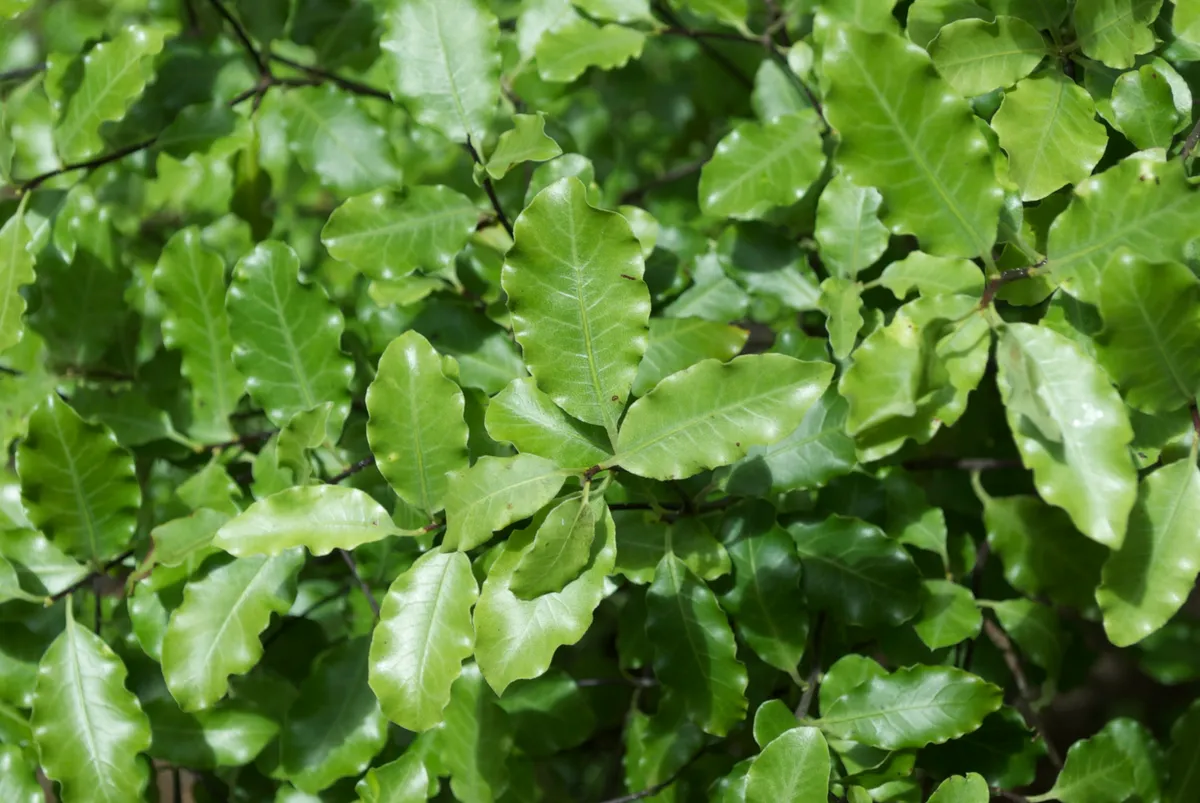
A New Zealand evergreen normally grown as a large, flame-shaped shrub, but also a most attractive multi-stemmed tree if the lower branches are removed. The small, bright green shining leaves are waved at the edges and are carried on wiry dark stems. Tiny dark purple flowers appear in late spring and early summer. These can go unnoticed, but their rich honey-fragrance is unmissable in the evening.
Pittosporum tenuifolium grows on any well-drained soil. It is a good subject for coastal gardens and milder areas. It needs full sun or partial shade and ideally some shelter. Severe cold can cause leaf drop and damage.
The foliage is good for cutting and this tree responds well to pruning which is best done either in spring before growth commences or straight after flowering. Either prune selectively to maintain the loose, natural habit or trim for a more structural effect.
There are numerous cultivars, many of which are bushy shrubs rather than trees. Of the variegated forms the pale green and white
Pittosporum tenuifolium ‘Garnettii’ is one of the best to grow as a tree.
Avoid severe cold
Sun/shade? full sun or partial shade
Quercus ilex (8m x 6m)
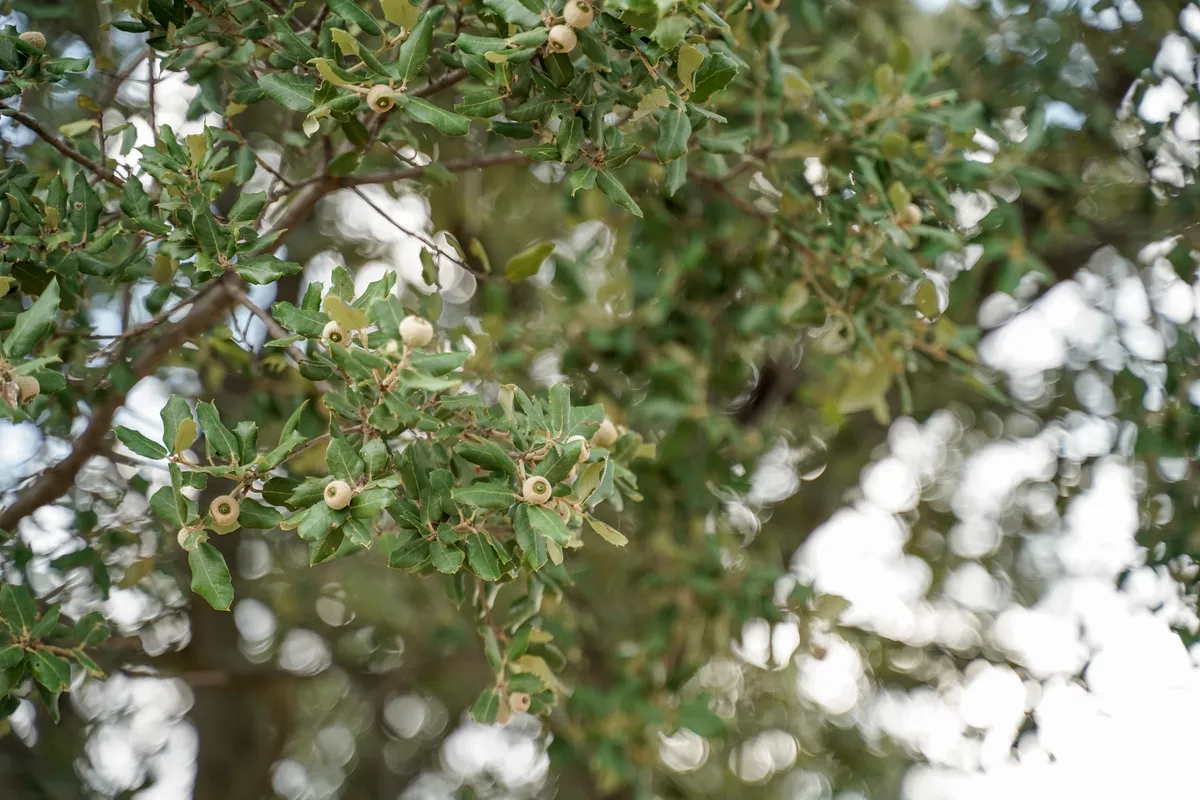
Commonly known as holm oak or evergreen oak this is eventually a very large, broad tree with a massive rounded crown, although often slow to grow at first. The tough, oval, dark green leaves have a dull shine above, but are often whitish beneath. The new leaves have the same whitish bloom. Short, pale yellow spring catkins give rise to green acorns. The bark is grey when young becoming charcoal grey and fissured as the tree matures. A long lived tree it could reach 20m when mature, so needs plenty of space if allowed to grow unchecked in ideal conditions.
Holm oak grows on any well drained soil and is drought tolerant, although summer leaf drop can be heavy in prolonged drought. It prefers full sun, but tolerates semi-shade and an exposed situation. Wind resistant it is good by the coast.
Although not essential it responds well to pruning and shaping which is useful in smaller gardens. When grown as a shrub it can be used for hedging and makes an excellent screening plant.
Needs plenty of space
Sun/shade? Prefers full sun but tolerates semi-shade
Taxus baccata (8m x 6m)
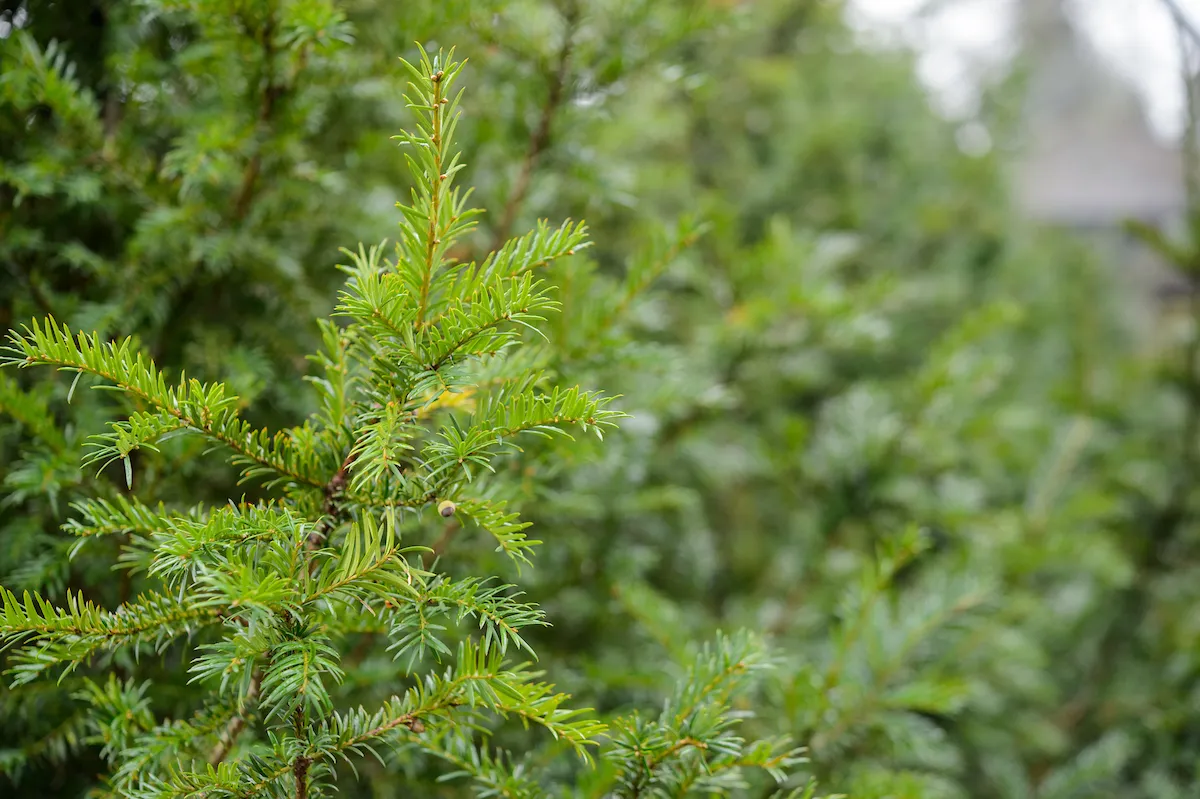
The common yew is a British native coniferous tree. The foliage is dark green, the habit bushy; the bark reddish brown and flaking in places. Female plants produce red berries that follow insignificant spring flowers. It can live until a great age: a yew tree is not regarded as ancient until over 900 years old.
Widely used as a structural element in gardens in the form of hedges and topiary it is often overlooked as an excellent evergreen tree. This could be due to its association with churchyards, an ancient custom that originated with the Druids.
Yew grows on any well-drained soil in sun or shade. It survives in exposed situations and on very thin, shallow soils. No pruning is essential, however it does respond well to trimming and shaping, hence its use as a hedging plant.
There are many selections and cultivars. Taxus baccata ‘Fastigiata’ forms a dense, upright column made of several upright stems from ground level. It can be used as an alternative to the Italian cypress.
Sun/shade? both
Pruning? Not essential